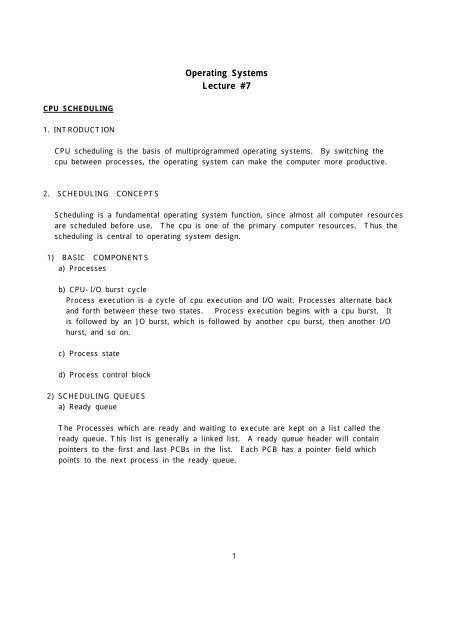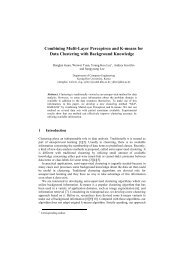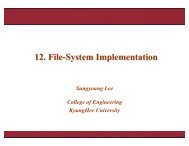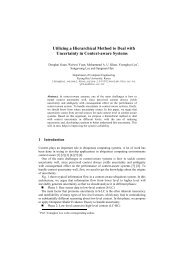Operating Systems Lecture #7 - Ubiquitous Computing Lab
Operating Systems Lecture #7 - Ubiquitous Computing Lab
Operating Systems Lecture #7 - Ubiquitous Computing Lab
Create successful ePaper yourself
Turn your PDF publications into a flip-book with our unique Google optimized e-Paper software.
<strong>Operating</strong> <strong>Systems</strong><br />
<strong>Lecture</strong> <strong>#7</strong><br />
CPU SCHEDULING<br />
1. INTRODUCTION<br />
CPU scheduling is the basis of multiprogrammed operating systems. By switching the<br />
cpu between processes, the operating system can make the computer more productive.<br />
2. SCHEDULING CONCEPTS<br />
Scheduling is a fundamental operating system function, since almost all computer resources<br />
are scheduled before use. The cpu is one of the primary computer resources. Thus the<br />
scheduling is central to operating system design.<br />
1) BASIC COMPONENTS<br />
a) Processes<br />
b) CPU-I/O burst cycle<br />
Process execution is a cycle of cpu execution and I/O wait. Processes alternate back<br />
and forth between these two states. Process execution begins with acpu burst. It<br />
is followed by an ]O burst, which is followed by another cpu burst, then another I/O<br />
hurst, and so on.<br />
c) Process state<br />
d) Process control block<br />
2) SCHEDULING QUEUES<br />
a) Ready queue<br />
The Processes which are ready and waiting to execute are kept on a list called the<br />
ready queue. This list is generally a linked list. A ready queue header will contain<br />
pointers to the first and last PCBs in the list. Each PCB has a pointer field which<br />
points to the next process in the ready queue.<br />
1
) Device queue<br />
The list of processes waiting for a particular I/O device is called adevice queue.<br />
c) Processing of queues<br />
A process enters the system from the outside world and is put in the ready queue.<br />
It waits in the ready queue until it is selected for the cpu. After running on the cpu,<br />
it waits for an I/O operation by moving to an I/O queue. Eventually, it is served<br />
by the I/O device and returns to the ready queue. A process continues this cpu-<br />
I/O cycle until it finishes; then it exits from the system.<br />
3) SCHEDULERS<br />
a) Long-term scheduler<br />
*Determines which jobs are admitted to the system for processing.<br />
*Controls degree of multiprogramming (the number of processes in memory)<br />
*Selects a good job mix of I/O-bounded and cpu-bounded jobs.<br />
b) Short-term scheduler (cpu scheduler)<br />
*Selects (quite o[ten) from among the jobs in memory which are ready to execute<br />
and allocates the cpu to one of them.<br />
c) Dispatcher<br />
*The module that actually gives control of the cpu to the process selected by the<br />
short-term scheduler.<br />
3. SCHEDULING ALGORITHMS<br />
1) PERFORMANCE CRITERIA<br />
a) CPU utilization: range from 0 percent to 100 percent.<br />
b) Throughput: number of jobs which are completed per time unit.<br />
c) Turnaround time: the interval from the time of submission to the time of completion.<br />
d) Waiting time: the amount of time that a job spends waiting in the ready queue.<br />
e) Response time: the time from the submission of a request until the first response<br />
is produced (the amount of time it take to start responding. not the<br />
time that it takes to output that response),<br />
Note: A system with reasonable and predictable response time may be considered better<br />
than a system which is faster on the average, but highly variable.<br />
2
2) FIRST-COME-FIRST-SERVED (FCFs)<br />
The code for FCFS scheduling is simple to write and understand. The Performance of<br />
FCFS, however, is often quite poor.<br />
3) SHORTEST-JOB-FIRST<br />
Shortest-Job-First (SJF) is probably optimal, in that it gives the minimum average<br />
waiting time for a given set of jobs.<br />
The real difficulty with SJF is knowing the length of the next cpu request.<br />
approach is to try to approximate SJF scheduling.<br />
One<br />
4) PRIORITY<br />
SJF is a special case of the general priority scheduling algorithm. A SJF algorithm is<br />
simply apriority algorithm where the priority (p) is the inverse of the (predicted) next<br />
cpu burst (tau): p =1/tau<br />
Priority can be defined either internally or externally.<br />
Major problem with priority scheduling algorithms is indefinite blocking or starvation.<br />
Aging for low-priority jobs may be solution to the this problem.<br />
Each job is assigned apriority.<br />
FIFO within each priority level.<br />
Select highest priority job over lower ones.<br />
Priority may based on:<br />
- Cost to user.<br />
- Importance of user<br />
- Aging<br />
- Percentage of CPU time used in last X hours<br />
Indefinite blocking or starvation aproblem<br />
5) PREEMPTIVE ALGORITHMS<br />
FCFS, SJF, and priority algorithms, as described so far, are non-preemptive scheduling<br />
algorithms. (FCFS: Non-preemptive, SJF and Priority: either preemptive or nonpreemptive).<br />
Preemptive Shortest-Job-First is sometimes called Shortest-Remaining_Time<br />
-First.<br />
6) ROUND-ROBIN (RR)<br />
The RR scheduling algorithm (preemptive) is designed especially for time-sharing<br />
systems. A small unit of time. called time quantum (generally from 10 to 100<br />
3
milliseconds) or slice, is defined.<br />
Example)<br />
Time quantum is 4.<br />
Job Burst time<br />
1 24<br />
2 3<br />
3 3<br />
Average turn around time is (7 + 10 + 30)/3 =16<br />
In the RR scheduling algorithm, no process is allocated the cpu for more than one time<br />
quantum in arow. If its cpu bursts exceeds a titre quantum, it is preempted and put<br />
back in the ready queue.<br />
If time quantum is very large (in mite), RR is the same as FCFS. If the time quantum<br />
is very small, RR is called processor sharing.<br />
RR has context switch problems. A suggested rule-of-thumb is that 80 percent of the<br />
cpu bursts should be shorter than the time quantum.<br />
7) MULTI-LEVEL QUEUES<br />
A multi*queue scheduling algorithm partitions the ready queue into separate queues.<br />
Jobs are permanently assigned to one queue, generally based upon some property of the<br />
job, such as memory size or job type. Each queue has its own scheduling algorithm.<br />
In addition, there must be scheduling between the queues. Jobs do not move between<br />
queues.<br />
Processes assigned to one queue permanently<br />
Scheduling between queues: Fixed priority<br />
Example:<br />
- System processes<br />
- Interactive programs<br />
- Interpretive editing<br />
- Batch processes<br />
- Student process<br />
8) MULTI-LEVEL FEEDBACK QUEUES<br />
Allow ajob to move between queues. The idea is to separate out jobs with different<br />
cpu-burst characteristics. If a job uses too much cpu time, it will be moved to alower<br />
priority queue.<br />
4
Multi-Level Queue with priorities<br />
Processes move between queue<br />
Each queue represents jobs with similar CPU usage<br />
Jobs in a given queue are executed with agiven timeslice<br />
9) REAL-TIME SCHEDULING<br />
periodic scheduler<br />
Demand4riven schedulers<br />
Deadline Scheduler<br />
Aperiodic Scheduler<br />
Sporadic Scheduler<br />
4. ALGORITHM EVALUATION<br />
1) ANALYTIC EVALUATION<br />
a) Deterministic modeling<br />
b) Queueing models<br />
2) SIMULATIONS<br />
3) IMPLEMENTATION<br />
II. DEADLOCK<br />
1. DEFINITIONS<br />
A process is deadlocked if it is waiting for an event that will never occur. Typically, but<br />
not necessarily. more than one process will be involved together in adeadlock.<br />
A process is indefinitely postponed if it is delayed repeatedly over a long period of time<br />
while the attention of the system is given to other processes i. e., logically the process<br />
may<br />
proceed but the system never gives in the CPU.<br />
2. RESOURCES<br />
Resource is a commodity needed by a process. Resources work by order of a process or<br />
another resource; processes do not.<br />
5
* Resources can be either:<br />
-Serially reusable: CPU, memory, disk space. I/O devices, files.<br />
acquire --> use --> release<br />
-Consumable: produced by aprocess, needed by a process; massage, buffers of<br />
information. interrupts.<br />
create ---> acquire --> use<br />
Resource ceases to exist after it has been used, so it is not released.<br />
*Resources can also be either.<br />
-Preemptible: CPU, central memory<br />
-Nonpreemptible: Tape drives<br />
*Resource can be either:<br />
-Shared among several processes<br />
-dedicated exclusively to single process<br />
3. CONDITIONS FOR DEADLOCK<br />
The following 4 conditions are both necessary and sufficient for deadlock:<br />
1> Mutual exclusion: Processes claim exclusive control of the resources they require<br />
2> Wait-for condition: Process hold resources already allocated Io them while waiting for<br />
additional resources<br />
3> No preemption condition: Resources cannot be removed from the process holding them<br />
until used to completion.<br />
4> Circular wait condition: A circular chain of processes exist in which process holds one<br />
or more resources that are requested by the next process in the chain.<br />
4. DEADLOCK ISSUES<br />
*Prevention: Design a system in such a way that deadlocks cannot occur, at least with<br />
respect to serially reusable resources.<br />
*Avoidance: Impose less stringent conditions than for prevention, allowing the possibility<br />
of deadlock, but sidestepping it as it approaches.<br />
*Detection: In .a system that allows the possibility of deadlock, determine if deadlock has<br />
occurred, and which processes and resources axe involved.<br />
*Recovery: After a deadlock has been detected. clear the problem. allowing the<br />
deadlocked<br />
processes to complete and the resources to be reused. Usually involves destroying the<br />
affected processes and starting them over.
5. RESOURCE ALLOCATION GRAPH<br />
6. DEADLOCK PREVENTION: HARVENDER'S ALGORITHMS<br />
If any one of the condition for deadlock (with reusable resources) is defined, deadlock is<br />
impossible.<br />
1> Mutual exclusion: We don't want to deny this; exclusive use of resources is an<br />
important feature.<br />
2> Wait-for condition: Force each process to request all required resources at once. It<br />
cannot proceed until all resources have been acquired.<br />
3> No preemption condition: If a process holding some reusable resources makes a further<br />
request which is denied, and it wishes to wait for the new resources to become<br />
available,<br />
it must release all resources currently held and, if necessary, request them again along<br />
with the new resources. Thus, resources am removed from a process holding them<br />
4> Circular wait condition: All resource types are numbered. Processes must request<br />
resources in numerical order;, if a resource of type N is held, the only resources which<br />
can be requested must be of types > N.<br />
7. DEADLOCK AVOIDANCE<br />
*Set of resource<br />
*Set of customers<br />
*Banker<br />
1> Each customer tells banker the maximum number of resources it needs<br />
2> Customer borrows resources from banker<br />
3> Customer returns resources to banker<br />
4> Customer eventually pay back loan<br />
*Bankers only lends resources if the system will be in a safe state after the loan<br />
*Safe state: there is lending sequence such that all customers can take out a loan<br />
*Unsafe state: there is a possibility of deadlock<br />
7
8. BANKER'S ALGORITHM<br />
Step 1. If Request*
Allocation Max Need Available<br />
A B C A B C A B C A B C<br />
P0 0 1 0 7 5 3 7 4 3 2 3 0<br />
P1 3 0 2 3 2 2 0 2 0<br />
P2 3 0 2 9 0 2 6 0 0<br />
P3 2 1 1 2 2 2 0 1 1<br />
P4 0 0 2 4 3 3 4 3 1<br />
d. The sequence satisfies the safety requirement<br />
*Example 2:<br />
Allocation Max Available<br />
A B C D A B C D A B C D<br />
P0 0 0 1 2 0 0 1 2 1 5 2 0<br />
P1 1 0 0 0 1 7 5 0<br />
P2 1 3 5 4 2 3 5 6<br />
P3 0 6 3 2 0 6 5 2<br />
P4 0 0 1 4 0 6 5 6<br />
1) Is the system in a safe state?<br />
Answer: Yes, the sequence satisfies the safety requirement.<br />
2) If a request from process P1 arrives for t0, 4, 2, 01 can the request be granted<br />
immediately?<br />
Answer: Yes. Since<br />
a. (0, 4, 2, 0)
*Banker Solution Issues<br />
- Process may not terminate<br />
- Process may request more than claim<br />
- A process may suffer indefinite postponement<br />
a) Solution is to check for aged process<br />
b) Select an allocation sequence that includes aged process<br />
c) Only select requests that follow that sequence until aged process executes<br />
9. DEADLOCK DETECTION<br />
*Check to see if a deadlock has occurred<br />
*Multiple resources per type<br />
- Run variant of previous algorithm to see if processes can finish<br />
- Order(n 2 ) operations, n nodes in graph<br />
*How often should the detection algorithm be run?<br />
*How many processes will be affected by deadlock?<br />
10. RECOVERY FROM DEADLOCK<br />
*Kill deadlocked processes and release resources<br />
*Kill one deadlocked process at atime and release its resources<br />
*Rollback all or one of the processes Io a checkpoint that occurred before they requested<br />
any resources<br />
10
II. REAL-TIME SCHEDULING<br />
1. WHAT IS REAL-TIME SYSTEMS<br />
1) DEFINITION OF REAL_TIME COMPUTING<br />
The correctness of the system depends not only on the logical result of the<br />
but also on the time at which the results are produced.<br />
2) APPLICATION AREAS<br />
a) Nuclear power plant control<br />
b) Factory automation<br />
c) Air traffic control<br />
d) Telecommunication systems<br />
e) Military defense systems<br />
3) CHARACTERISTICS OF REAL-TIME SYSTEMS<br />
a) Largeness and complexity<br />
b) Reliability and safety<br />
c) Concurrent Control<br />
d) Real-Time control<br />
2. ISSUES IN REAL-TIME SYSTEMS<br />
l) REAL-TIME ISSUES<br />
a) How to represent time<br />
b) How to control time constraints<br />
2) DESIGN AND ANALYSIS ISSUES<br />
a) Finite State Machine<br />
b) Floid Logic<br />
c) Stochastic Petri Net (SPN)<br />
d) Temporal Logic<br />
e) Statecharts<br />
3) LANGUAGE ISSUES<br />
4) VERIFICATION ISSUES
3. REAL-TIME OPERATING SYSTEMS<br />
1) CONVENTIONAL REAL-TIME OPERATING SYSTEM KERNEL<br />
a) Fast context switching<br />
b) Small size<br />
c) Fast interrupt latency<br />
d) Fast response to external interrupts<br />
e) No virtual memory<br />
f) Maintain real-time clock<br />
2) ISSUES IN DISTRIBUTED REAL-TIME SYSTEMS<br />
a) Inflexible Real-Time Scheduler (Cyclic Executive Model)<br />
b) Lack of Real-Time Communication Protocols<br />
c) Priority inversion<br />
4. REAL-TIME SCHEDULING<br />
1) REAL-TIME COMPUTATION MODEL<br />
a) Classification of task<br />
Real-Time Task<br />
Hard Real-Time<br />
Soft Real-Time<br />
Periodic task<br />
Sporadic task<br />
Periodic task<br />
Aperiodic task<br />
b) Classification Categories<br />
*Number of processor<br />
*Task duration (equal/unequal)<br />
*Precedence relationship (independent/dependent)<br />
*Task interpretability (preemptive/nonpreemptive)<br />
*Job periodicity (periodic/aperiodic)<br />
*Presence/absence of deadline (hard/soft-real time)<br />
*Resource-limited/not limited<br />
*Homogeneous/Heterogeneous processors
3) MEASURE OF MERIT IN REAL-TIME SYSTEMS<br />
a) Predictability<br />
b) High degree of schedulability<br />
c) Stability under transient overload<br />
4) SCHEDULING DIFFERENCES BETWEEN OR AND REAL-TIME OS<br />
a) Operation Research<br />
*Scheduling performed statically<br />
*Off-Line<br />
*Assume all the jobs are scheduled and available at t--0<br />
*No new job appeal- during processing<br />
b) Real-Time <strong>Operating</strong> <strong>Systems</strong><br />
*Scheduling decisions is made dynamically<br />
*On-line<br />
*Irregular arrival/departure of processes<br />
*Stochastic processing time<br />
5. SCHEDULING PERIODIC TASKS<br />
1) REQUIREMENTS: Continuously meeting periodic and sporadic timing constraints in<br />
real-time<br />
2) TRADITIONAL REAL-TIME SCHEDULING<br />
Cyclical Executive:<br />
- Ad hoc manner<br />
- Hard to modification<br />
- Time consuming (fitting code into time slot)<br />
3) RATE MONOTONIC SCHEDULING ALGORITHM<br />
a) Idea: Rate Monotonic priority assignment (assign priority tasks according to their<br />
request rates (1/Ti where Ti is period of task i)<br />
b) Theorem: Aset of n independent periodic tasks scheduled by the rate monotonic<br />
algorithm will always meet its deadlines if;<br />
∑CTi ≦ n(2<br />
1/∂ -1)<br />
where Ci and Ti are execution time: and period of task irespectively
6. SCHEDULING APERIODIC TASKS<br />
1) BACKGROUND APERIODIC SERVICE<br />
Aperiodic<br />
Request #1<br />
Aperiodic<br />
Request #2<br />
Task<br />
Execution<br />
0 2 4 6 8 10 12 14 16 18 20<br />
Periodic Tasks:<br />
Execution Time Period Priority<br />
Task A<br />
4 10 High<br />
Task B<br />
8 20 Low<br />
2) POLLING SERVICE<br />
Aperiodic<br />
Request #1<br />
Aperiodic<br />
Request #2<br />
Task<br />
Execution<br />
0 2 4 6 8 10 12 14 16 18 20<br />
1.0<br />
Polling Server<br />
Capacity<br />
0 2 4 6 8 10 12 14 16 18 20<br />
Polling Server: Executio Time = 1, Period = 5<br />
Periodic Tasks:<br />
Task A<br />
Execution Time Period Priority<br />
4 10 High<br />
Task B<br />
8 20 Low
3) DEFERRABLE SERVER<br />
a) Idea: Provide amechanism for preserving the resource bandwith allocated for aperiodic<br />
service.<br />
b) Example<br />
Aperiodic<br />
Request #1<br />
Aperiodic<br />
Request #2<br />
Task<br />
Execution<br />
0 2 4 6 8 10 12 14 16 18 20<br />
Deferrable Server<br />
Capacity<br />
1.0<br />
0.0<br />
0 2 4 6 8 10 12 14 16 18 20<br />
4) PRIORITY EXCHANGE<br />
a) Idea: Preserves its high priority execution time by exchanging it for the execution of<br />
lower priority periodic task<br />
b) Example<br />
Aperiodic<br />
Request #1<br />
Aperiodic<br />
Request #2<br />
Task<br />
Execution<br />
0 2 4 6 8 10 12 14 16 18 20<br />
Priority Exchange<br />
Server Capacity<br />
Priority Exchange Server: Execution Time = 1, Period = 5<br />
Level #1<br />
1<br />
0 2 4 6 8 10 12 14 16 18 20<br />
Level #2<br />
1<br />
0 2 4 6 8 10 12 14 16 18 20<br />
3<br />
Level #3<br />
2<br />
1<br />
0 2 4 6 8 10 12 14 16 18 20
6. SCHEDULING SPORADIC TASKS<br />
a) Idea: Deadline monotonic priority assignment (instead of rate monotonic assignment).<br />
b) Example<br />
Deadline Monotonic Priority Assignment:<br />
Rate Exec Time Deadline Priority<br />
32 8 10 1<br />
12 4 12 2<br />
20 4 20 3<br />
Aperiodic<br />
Request<br />
Deadline<br />
Met<br />
Task<br />
Execution<br />
0 2 4 6 8 10 12 14 16 18 20










